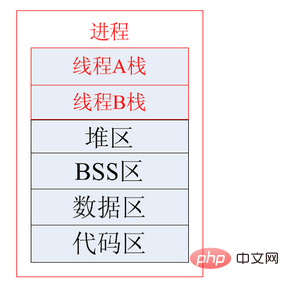
Linux processes and threads: 1. The difference is that different operating system resource management methods, processes have independent address spaces, but there is no separate address space between threads; 2. The connection is that a thread can be created and canceled Another thread, multiple threads in the same process can execute concurrently, and threads are just different execution paths in a process.

#The operating environment of this tutorial: linux7.3 system, Dell G3 computer.
Contact:
One thread can create and cancel another Threads; multiple threads in the same process can execute concurrently.
Compared with processes, threads are a concept closer to execution bodies. They can share data with other threads in the same process. But it has its own stack space and an independent execution sequence.
Difference:
The main difference between processes and threads is that they are different operating system resource management methods. The process has an independent address space. After a process crashes, it will not affect other processes in protected mode, and threads are just different execution paths in a process. Threads have their own stacks and local variables, but there is no separate address space between threads. The death of one thread is equivalent to the death of the entire process. Therefore, multi-process programs are more robust than multi-thread programs, but when switching processes, it consumes a lot of time. The resources are larger and the efficiency is lower. However, for some concurrent operations that require simultaneous operation and sharing of certain variables, only threads, not processes, can be used.
In short, a program has at least one process, and a process has at least one thread.
The division scale of threads is smaller than that of processes. This enables high concurrency of multi-threaded programs.
In addition, the process has an independent memory unit during execution, and multiple threads share memory, thus greatly improving the running efficiency of the program.
Threads are still different from processes during execution. Each independent thread has an entry point for program execution, a sequential execution sequence, and an exit point for the program. However, threads cannot execute independently and must exist in the application program, and the application program provides multiple thread execution control.
From a logical point of view, the meaning of multi-threading is that in an application, multiple execution parts can be executed at the same time. However, the operating system does not regard multiple threads as multiple independent applications to implement process scheduling and management and resource allocation. This is the important difference between processes and threads.
Extended knowledge
In many classic operating system textbooks, the process is always defined as the execution of the program An instance does not perform anything, it just maintains various resources required by the application, while a thread is the real execution entity.
In order for a process to complete a certain amount of work, the process must contain at least one thread.

Process, intuitively speaking, after the program saved on the hard disk is run, an independent memory body will be formed in the memory space. This memory body has its own address space. , has its own heap, and the upper-level affiliated unit is the operating system.
Threads exist in processes and are the smallest units for scheduling and execution by the operating system. To put it simply, threads do work. \color{red}{Threads are what work. }Threads are what do the work.
A process is a program with certain independent functions. A running activity on a certain data set. A process is an independent unit for resource allocation and scheduling in the system. A thread is an entity of a process and the basic unit of CPU scheduling and dispatch. It is a basic unit that is smaller than a process and can run independently. The thread itself basically does not own system resources, only a few resources that are essential for running (such as a program counter, a set of registers and a stack), but it can share all the resources owned by the process with other threads belonging to the same process. .
If the process is a resource steward, responsible for requesting resources from the owner, then the thread is the hard worker. If the process is a resource steward, responsible for requesting resources from the owner, then the thread is the hard worker. A housekeeper must complete a job, which requires at least one coolie. That is to say, a process contains at least one thread and can also contain multiple threads. If coolies want to work, they need to rely on the housekeeper, so a thread must belong to a certain process. The process has its own address space, and threads use the address space of the process. In other words, threads have access to the resources in the process, such as heaps, stacks, static storage areas, etc.
The thread is a proletariat, but when the proletariat works, it must have its own labor tool. This labor tool is the stack. The thread has its own stack. This stack still uses the address space of the process, but this space is used Threads are marked as stacks. Each thread will have its own private stack, which cannot be accessed by other threads.
What the process maintains are the resources (static resources) contained in the program, such as: address space, open file handle set, file system status, signal processing handler, etc.;
Threads maintain Maintained run-related resources (dynamic resources), such as: running stack, scheduling-related control information, signal sets to be processed, etc.;
Threads and processes have their own advantages and disadvantages in use: Thread execution overhead Small, but not conducive to resource management and protection; and the process is just the opposite.
Recommended learning: Linux video tutorial
The above is the detailed content of What is the difference and connection between linux processes and threads. For more information, please follow other related articles on the PHP Chinese website!